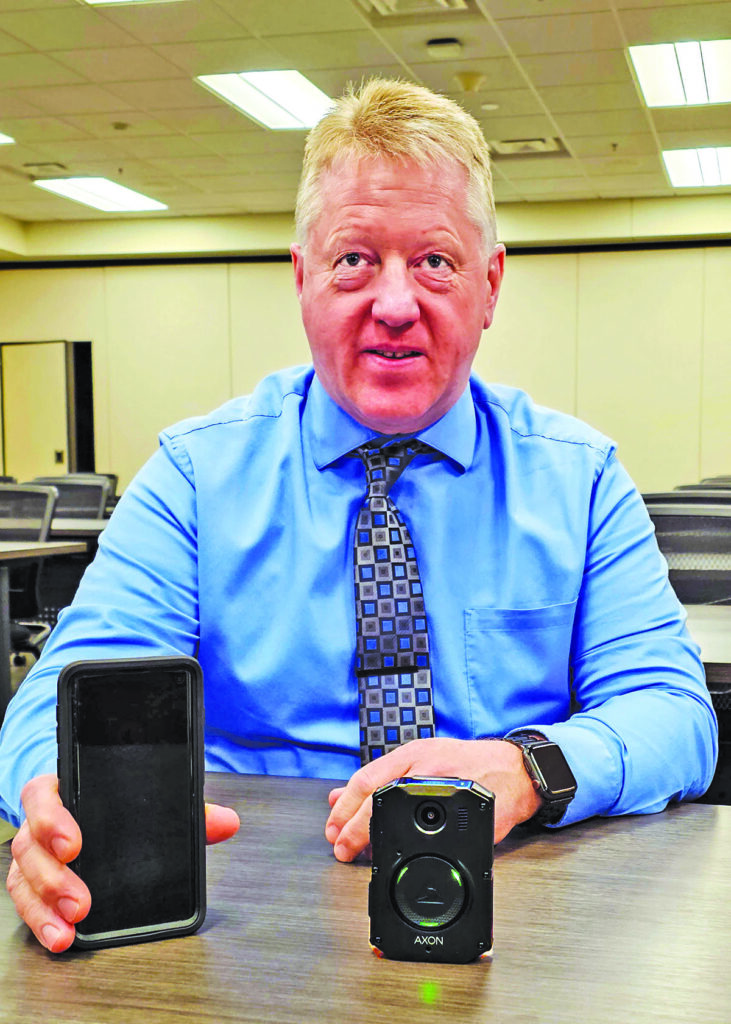
Chief Shannon Monroe displays his own body cam next to his smartphone. The sizes are similar, though the camera is thicker. (Photos/Nancy Hanson.)
Nancy Edmonds Hanson
Moorhead police officers clipped something new to their uniforms Monday – body cameras that turn on automatically, capturing the action when they respond to calls and interact with citizens.
Eighteen months of research have helped Chief Shannon Monroe accomplish something that’s been on his mind since he took over leadership of the Moorhead Police Department in 2018. “We have known that body cams were the wave of the future,” he says. “But back then, the Legislature hadn’t caught up with the technology yet.”
The cameras, worn clipped to the front of officers’ uniforms, are already familiar to members of the Minnesota State Patrol and Fargo Police Department, along with a number of smaller agencies in Clay County. “We have been a little slow … on purpose,” the chief explains. “We’ve been deliberately careful to let state law catch up with the capabilities of this equipment, and to make sure that our people are comfortable with the devices that we’ve chosen.
“We don’t want to be on the bleeding edge of technology. Nobody wants to see the police make a mistake.”
The department has been working with the city council and Moorhead’s information technology and finance departments to select the cellphone-sized devices and incorporate them into police practices. After extensive field testing by officers, the planning group chose the cameras developed and supported by Axon Enterprise Inc. The company was already familiar to the MPD, both for its “conducted electrical weapons” (tasers) and the cameras mounted on the dash of Moorhead squad cars, where they begin recording whenever the rooftop light bars are turned on.
In addition to the body cams themselves, Axon will provide digital management and support, including storage of the vast amount of video data to be collected in the field. The contract includes secure cloud-based storage of an unlimited volume of BWC (body-worn camera) data. (Cloud-based data is stored in an off-site location that can be accessed through the internet or a dedicated private network connection.)
The city is investing half a million dollars – $100,000 in each of the next five years. Its contract includes at least one future upgrade of the 71 cameras now assigned to sworn officers, community service officers and police cadets, along with services like redaction (blurring) of the faces of juveniles and private citizens not involved in police actions and security of the data. In most criminal cases, it will be maintained for as much as seven years, Monroe says, adding, “If it’s part of the record in cases of homicide, we’ll keep it forever.” The city IT department has also added a third staff member to work with the data.
Capt. Deric Swenson points out that the cameras do not record continuously. While officers can turn them on manually, the cellphone-size devices activate automatically when a firearm or taser is unholstered. They transmit an automatic signal to other nearby officers, simultaneously activating their own cameras. The video livestream can be accessed by supervisors back at the Law Enforcement Center during critical incidents, including barricaded suspects or an active shooter situation. Supervisors can also pinpoint each officer’s exact location via onboard GPS.
According to the chief, MPD’s counterparts in Duluth pioneered the use of body cams shortly after body-cam regulations were instituted in 2018 as part of the Minnesota Government Data Practices Act. That law closely governs who can see the video, including prosecutors and defense attorneys in criminal cases. Under the regulations, data is generally considered private throughout investigations, except when presented as evidence in court. When the investigation is complete, it becomes public if it documents an incident where an officer discharges a weapon in the course of duty or if the use of force results in substantial bodily harm.
Swenson says officers in other jurisdictions whom they consulted have been uniformly positive about adding the cameras to their gear. “Fargo officers have told us that they love them. They wish they’d had them sooner,” he reports. “That was most important thing to us – that our line staff will be comfortable wearing and using them.”
Not only do the body cams provide real-time intelligence of what’s happening out in the field, he explains: “They protect officers from unfounded allegations about the use of excessive force.”
Monroe adds, “And if seeing those body cams helps people behave better, knowing they’re being recorded … well, that’s a better deal for everyone involved.”


